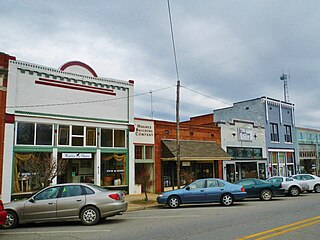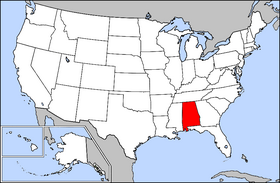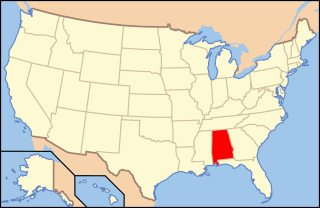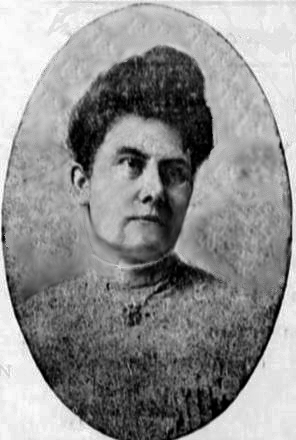Related Research Articles

Montevallo is a city in Shelby County, Alabama, United States. A college town, it is the home of the University of Montevallo, a public liberal arts university with approximately 3,000 students. As of the 2020 census, the population of the city of Montevallo is 7,229.

The Southern Christian Leadership Conference (SCLC) is an African-American civil rights organization based in Atlanta, Georgia. SCLC is closely associated with its first president, Martin Luther King Jr., who had a large role in the American civil rights movement.

The University of Montevallo is a public university in Montevallo, Alabama. Founded on October 12, 1896, the university is Alabama's only public liberal arts college and a member of the Council of Public Liberal Arts Colleges. The University of Montevallo Historic District was established on campus in 1979. The school is located in a rural location in central Alabama.

The General Federation of Women's Clubs (GFWC), founded in 1890 during the Progressive Movement, is a federation of approximately 2,300 women's clubs in the United States which promote civic improvements through volunteer service. Community Service Projects (CSP) are organized by local clubs for the benefit of their communities or GFWC's Affiliate Organization (AO) partnerships. GFWC maintains nearly 60,000 members throughout the United States and internationally. GFWC is one of the world's largest and oldest nonpartisan, nondenominational, women's volunteer service organizations.The GFWC headquarters is located in Washington, D.C.

The Alabama High School Athletic Association (AHSAA), based in Montgomery, is the governing body for interscholastic athletics and activities programs for public schools in Alabama.

The following is an alphabetical list of articles related to the U.S. state of Alabama.
An Alabama's Colored Women's Club refers to any member of the Alabama Federation of Colored Women's Club, including the "Ten Times One is Ten Club", the Tuskegee Women's Club, and the Anna M. Duncan Club of Montgomery. These earliest clubs united and created the Alabama Federation of Colored Women's Club in 1899. By 1904, there were more than 26 clubs throughout Alabama. The most active ones were in Birmingham, Selma, Mobile, Tuskegee, Tuscaloosa, Eufaula, Greensboro, and Mt. Megis.

The Atlanta Woman’s Club is one of oldest non-profit woman’s organizations in Atlanta, organized November 11, 1895. It is a 501(c)3 non-profit philanthropic organization made up of professional women of all ages, races and religions.

Patricia Swift Blalock was an American librarian, social worker, and civil rights activist born in Gadsden, Alabama.

Czarina Conlan (1871-1958) was a Choctaw-Chickasaw archivist and museum curator. She worked at the Oklahoma Historical Society museum for 24 years. She founded the first woman's club in Indian Territory and served as the chair of the Oklahoma Indian Welfare Committee of the Oklahoma State Federation of Women's Clubs for 12 years. She was the first woman elected to serve on a school board in the state. Although the Attorney General of Oklahoma ruled she could not serve, she defied the order and completed a two-year term on the Lindsay School Board.

The woman's club movement was a social movement that took place throughout the United States that established the idea that women had a moral duty and responsibility to transform public policy. While women's organizations had existed earlier, it was not until the Progressive era (1896–1917) that they came to be considered a movement. The first wave of the club movement during the progressive era was started by white, middle-class, Protestant women, and a second phase was led by African-American women.
Rufus A. Lewis was an American civil rights activist and politician.
The Woman's Era Club was an African-American women's civic organization founded in Boston, Massachusetts, in between 1892 and 1894 by Josephine St. Pierre Ruffin. The club was the first black women's club in Boston. The organization was especially well known for the conflict caused when Ruffin attempted to desegregate the General Federation of Women's Clubs (GFWC) in 1900.
The Federation of Women's Clubs for Oklahoma and Indian Territories was formed in May, 1898. The motto selected for the organization was "Kindliness and Helpfulness". The first president was Sophia Julia Coleman Douglas.

This is a timeline of women's suffrage in Alabama. Women's suffrage in Alabama starts in the late 1860s and grows over time in the 1890s. Much of the women's suffrage work stopped after 1901, only to pick up again in 1910. Alabama did not ratify the Nineteenth Amendment until 1953 and African-Americans and women were affected by poll taxes and other issues until the mid 1960s.

Early women's suffrage work in Alabama started in the 1860s. Priscilla Holmes Drake was the driving force behind suffrage work until the 1890s. Several suffrage groups were formed, including a state suffrage group, the Alabama Woman Suffrage Organization (AWSO). The Alabama Constitution had a convention in 1901 and suffragists spoke and lobbied for women's rights provisions. However, the final constitution continued to exclude women. Women's suffrage efforts were mainly dormant until the 1910s when new suffrage groups were formed. Suffragists in Alabama worked to get a state amendment ratified and when this failed, got behind the push for a federal amendment. Alabama did not ratify the Nineteenth Amendment until 1953. For many years, both white women and African American women were disenfranchised by poll taxes. Black women had other barriers to voting including literacy tests and intimidation. Black women would not be able to fully access their right to vote until the passage of the Voting Rights Act of 1965.

Minnie Steckel was an American teacher, psychologist, clubwoman, and an activist involved in the women's poll tax repeal movement. Steckel began her career as a school teacher and worked her way up to school principal, superintendent and school psychologist, earning her bachelor's, master's and PhD degrees. From 1932 until her death in 1952, she was the dean of women and counselor at Alabama College. She served as president of the local Montevallo chapter of the American Association of University Women (AAUW) from 1937 to 1939, as president of the state chapter of the Business and Professional Women's Foundation and treasurer of the state chapter of the AAUW in 1951.
Cola Barr Craig was an author of the American South who wrote short stories and a novel. Also a clubwoman, she served as president of several organizations including the United Daughters of the Confederacy (U.D.C.), the Memorial Association of Selma, Alabama, and United Charities of Selma.
References
- 1 2 3 4 5 6 7 8 9 Owen, Thomas McAdory (1921). "Federation of Women's Clubs, The Alabama". History of Alabama and Dictionary of Alabama Biography. Vol. 1. S. J. Clarke publishing Company. pp. 574–83. Retrieved 7 December 2023.
 This article incorporates text from this source, which is in the public domain .
This article incorporates text from this source, which is in the public domain . - ↑ Alabama Federation of Women's Clubs (1921). Year Book – Alabama Federation of Women's Clubs. The Federation. Retrieved 7 December 2023.
 This article incorporates text from this source, which is in the public domain .
This article incorporates text from this source, which is in the public domain . - ↑ "Our history". gfwcalabama. Retrieved 7 December 2023.
- ↑ Cruikshank, George M. (1920). A History of Birmingham and Its Environs: A Narrative Account of Their Historical Progress, Their People, and Their Principal Interests. Lewis Publishing Company. pp. 266–67. Retrieved 7 December 2023.
 This article incorporates text from this source, which is in the public domain .
This article incorporates text from this source, which is in the public domain .